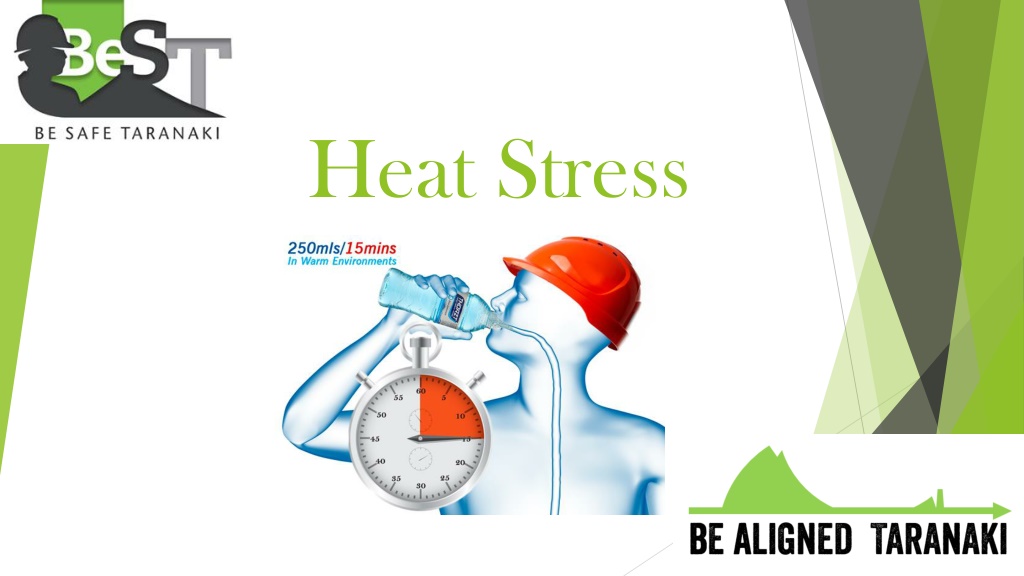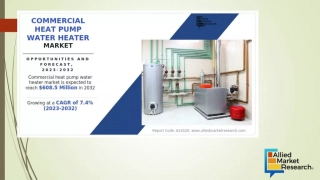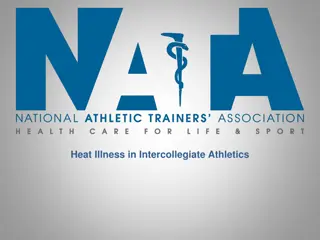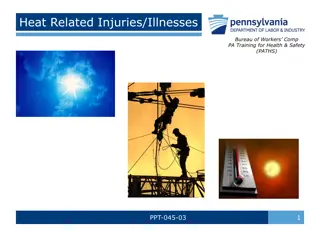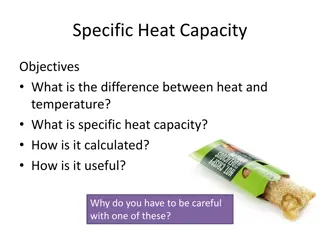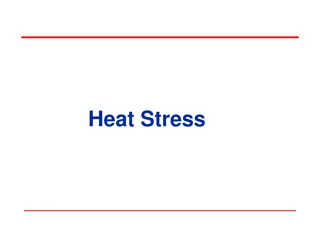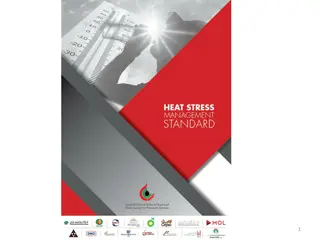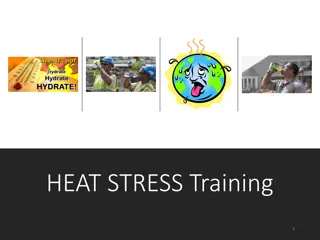Understanding Heat Stress and Prevention Techniques
Heat stress can lead to various heat-related illnesses and affect concentration at work. It's essential to be hydrated, wear appropriate gear, and monitor symptoms to prevent heat-related issues. Factors like hydration levels, environmental conditions, and personal health play a crucial role in managing heat stress effectively. By following preventive measures and knowing the symptoms of heat-related illnesses like heat exhaustion and heat stroke, workers can stay safe in hot conditions.
Uploaded on Sep 20, 2024 | 0 Views
Download Presentation

Please find below an Image/Link to download the presentation.
The content on the website is provided AS IS for your information and personal use only. It may not be sold, licensed, or shared on other websites without obtaining consent from the author. Download presentation by click this link. If you encounter any issues during the download, it is possible that the publisher has removed the file from their server.
E N D
Presentation Transcript
Body Temperature: The human core temperature is normally kept fairly constant in a range between about 36.5 C and 37.5 C During work in hot conditions, core temperatures can rise to as much as 38.5 C without significant risk of heat stroke
Effects of Heat: Exposure to excessive heat may: Reduce concentration, thus increasing the risk of an incident Induce heat related illness Aggravate the effects of other workplace hazards Aggravate pre-existing medical conditions
Types of Heat Stress: Heat Rash Heat Rash Heat Cramps Heat Cramps Heat Syncope Heat Syncope Heat Exhaustion Heat Exhaustion Heat Stroke Heat Stroke
Contributing Factors to Heat Stress: State of hydration Environmental conditions Operational factors Personal factors Acclimatization
Preventing Heat Stress: Plan the job Plan the job Wear PPE and sunscreen Are you fit for work? HYDRATE! Drink 1 cup of water every 15 minutes Wear PPE and sunscreen Are you fit for work? HYDRATE! Stop work and report to your supervisor if any symptoms of heat related illness develops Keep an eye on your work mates!
Heat Stress: HSWA does not state minimum or maximum safe temperatures for work HSWA requires PCBU to manage the risk https://www.worksafe.qld.gov.au/forms-and- resources/films/melting-man
Heat Related Illness: Heat Exhaustion Symptoms & Treatment In groups, take 5 minutes to discuss and write down what the symptoms of heat exhaustion look like. Then we will report back and discuss. In groups, take 5 minutes to discuss and write down what treatment is needed for someone suffering heat exhaustion. Then we will report back and discuss.
Heat Related Illness: Heat Stroke A Life Threatening Emergency CORE TEMPERATURE IS SO HIGH THAT THE BODYS ORGANS BECOME SEVERELY DAMAGED AND MALFUNCTION Characterized by: Confusion or irrational aggressive behavior Rapid shallow breathing Blurred vision Loss of consciousness may occur Convulsions / Seizures The skin may be hot and dry, although it can still be sweaty Rapid feeble pulse low pressure
Heat Stroke A Life Threatening Emergency Contact Emergency Services Follow DRSABCD Move the patient to a cool place Remove almost all clothing and loosen anything tight. Apply cold packs or ice to areas of large blood vessels (neck, groin and armpits) to accelerate cooling If possible, cover body with a wet sheet: fan to increase air circulation Stop cooling when the body feels cold to touch If the patient is fully conscious and is able to swallow give fluids
Remember... Know the signs & symptoms Plan the job Take regular rests in the shade Stay hydrated! Thank You
